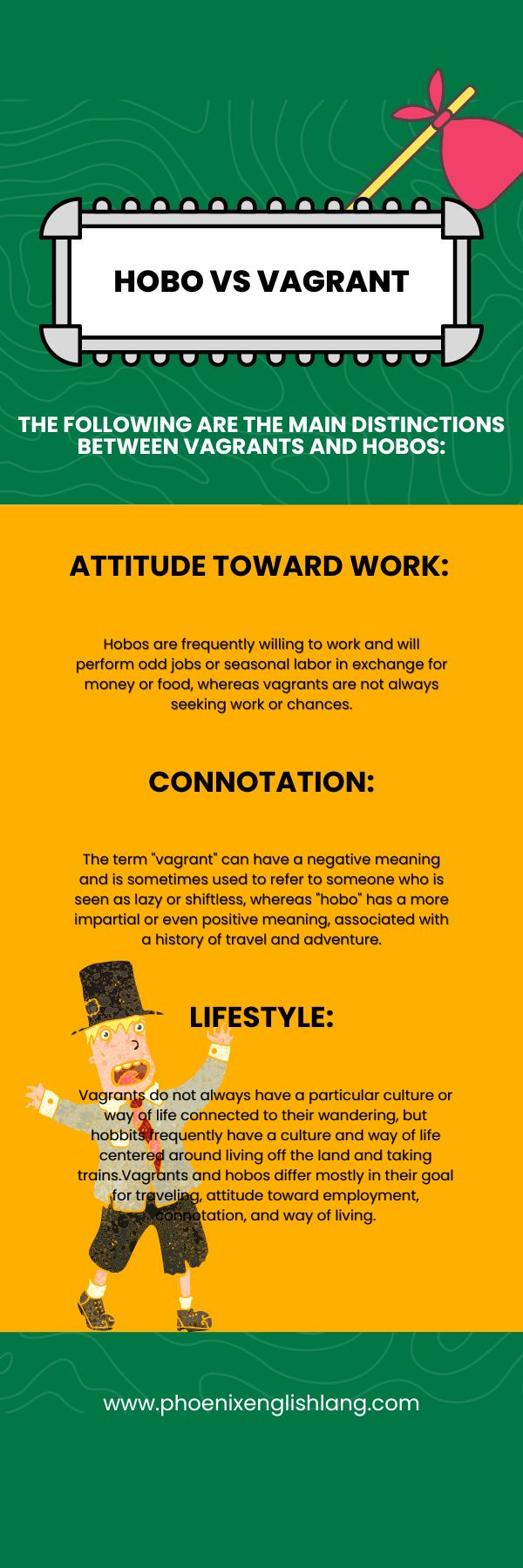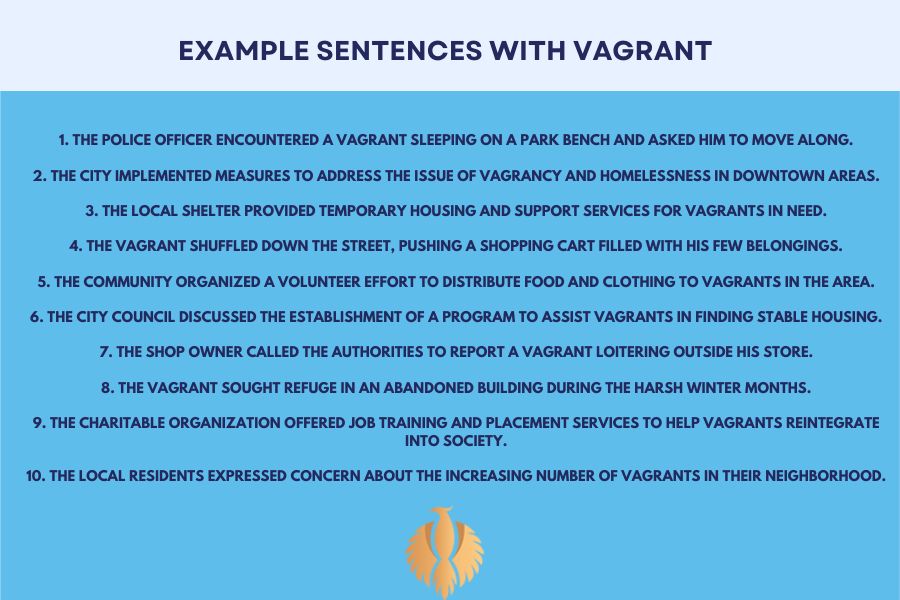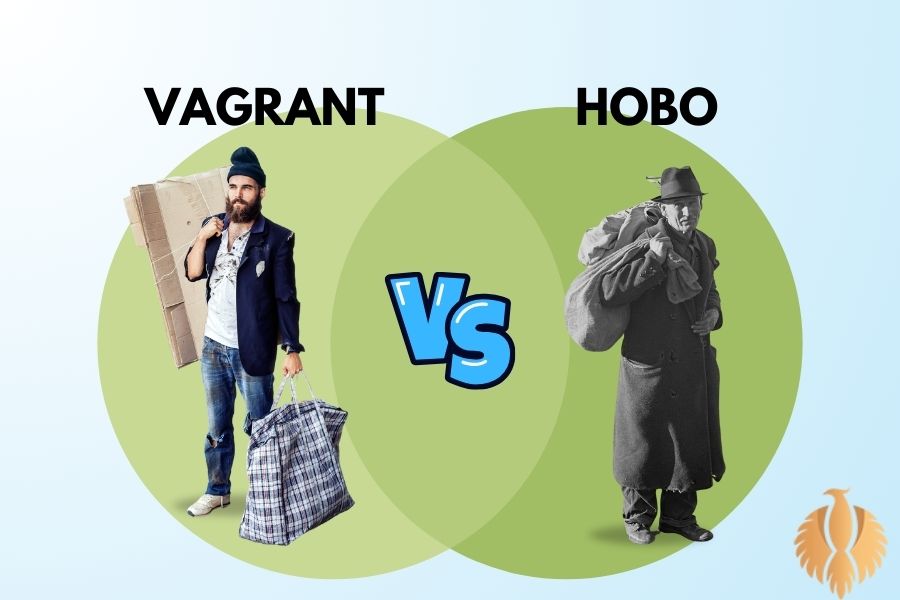As a teacher, I need to know so many words even if they sound weird to my students so today I decided to talk about two newly appeared words, just stay tuned with your favorite teacher, LOL!
wordsVagrant and hobo are both phrases used to describe persons who are destitute and roam from place to place, but their definitions differ slightly.
A vagrant is a homeless person who wanders from place to place without a definite direction or purpose, whereas a hobo is a homeless person who travels to find a job or better living conditions.
While both “hobo” and “vagrant” are terms used to describe individuals who do not have a permanent home, there are some differences in their connotations and usage.
The term “hobo” historically referred to a specific subculture of transient workers in the United States, particularly during the late 19th and early 20th centuries.
I’m telling you that Hobos were often migrant workers who traveled from place to place, often by hopping freight trains, in search of temporary employment. They had a unique code of ethics and a sense of camaraderie among themselves.
On the other hand, “vagrant” is a broader term that refers to anyone who lacks a fixed abode or regular employment.
Vagrancy laws have been used historically to regulate and control the movement of homeless or transient individuals.
Vagrants may include people who are homeless, living on the streets, or engaging in survival activities without a permanent residence.
On the whole, “hobo” typically refers to a specific historical subculture of transient workers, while “vagrant” is a more general term used to describe individuals who lack a permanent home or job.
Who is called a vagrant?
Let me now tell you more about Vagrants. A vagrant is a homeless individual who frequently moves around without a fixed address or a steady job. Addiction, mental illness, poverty, and other adversities may push vagrants into this lifestyle. When someone is called a “vagrant,” it can be taken negatively and used to describe someone who is thought to be careless or lazy.
You might also enjoy: Emersion Vs Immersion: Meaning, Differences, and Examples
Who is called a hobo?
A hobo is a homeless individual who moves around looking for employment or better living arrangements.
Hobos, as opposed to vagrants, are frequently willing to work and will perform seasonal or odd jobs in return for cash or food.
Hoboes have long been a part of American society and are frequently connected to the Great Depression, a time when severe poverty drove many people to live as vagrants or hobos.
Vagrant Vs Hobo

The following are the main distinctions between vagrants and hobos:
- Attitude toward work: Hobos are frequently willing to work and will perform odd jobs or seasonal labor in exchange for money or food, whereas vagrants are not always seeking work or chances.
- Connotation: The term “vagrant” can have a negative meaning and is sometimes used to refer to someone who is seen as lazy or shiftless, whereas “hobo” has a more impartial or even positive meaning, associated with a history of travel and adventure.
- Lifestyle: Vagrants do not always have a particular culture or way of life connected to their wandering, but hobbits frequently have a culture and way of life centered around living off the land and taking trains.
Vagrants and hobos differ mostly in their goal for traveling, attitude toward employment, connotation, and way of living.
Why is a hobo called this way?
The origin of the term “hobo” in the late 19th century is the subject of multiple theories. According to one theory that I’ve heard , the word comes from the Spanish word hombre, which means man.
According to a different theory, the word is derived from the Old English word hodbald, which means beggar. It’s also possible that American railroad workers in the 1800s used the term “hobo” as slang.
The phrase was used by the staff to describe passengers who boarded trains without purchasing a ticket.
“Riding the rods” or “riding the rails” was the term for this behavior. Regardless of its source, in the early 1900s, the term “hobo” started to be connected to vagrants who were on the move.
How is a hobo making money?
Hobo earns money in many ways, such as working odd jobs, scavenging, and begging. There is a difference between hobos and vagrants, even though vagrants are frequently confused with both.
A hobo is a person who chooses to lead a nomadic lifestyle. They frequently travel on freight trains, getting off at various stops to perform odd jobs before continuing their journey.
A vagrant, on the other hand, is a person who does not have a permanent residence or a place to live.
Both groups may beg or panhandle for money, but hoboes may do so to earn some extra cash while traveling, whereas vagrants are more likely to do so out of need.
You might also enjoy: Too Cute Meaning Vs To Cute (To Vs Too) + Examples
Is it impolite to refer to someone homeless as a “hobo” or “vagrant”?

These terms have historically been used to stigmatize and label those who are homeless.
Although they are not offensive in and of themselves, they can convey the idea that those who are homeless are shiftless, lazy, or undesirable.
It is generally more courteous to refer to those who are homeless as “homeless people,” “persons experiencing homelessness,” or “unhoused individuals.”
These terms are more sensitive and less stigmatizing. Ultimately, what matters most is to treat those who are homeless with respect and compassion, and to refrain from using language that could further marginalize or stigmatize the group.
Two categories of vagrants

So continue reading with me! In the past, there were two categories for vagrants: “sturdy beggars” and “rogues and vagabonds.”
People who were idle and aimlessly wandering were referred to as rogues or vagrants. They were punished by law enforcement because they were frequently perceived as a threat to social order.
Conversely, sturdy beggars were perceived as individuals who were eager to work but couldn’t find a job. They would frequently grovel for food or cash to survive. Even though some people continued to view them negatively, they were typically given more leniency than outlaws and wanderers.
Where does Vagrant originate from?
The word “vagrant” comes from the Latin word “vagari,” which means “to wander.” It entered the English language in the late 15th century and referred to a person who wanders from place to place with no permanent home or employment. Over time, the term has come to be associated with individuals who are homeless or live a transient lifestyle.
You might also enjoy: Reinforce Vs Reenforce: 10 Differences + Examples [2024]
Where does hobo originate from?
The word “hobo” is believed to have originated in the United States in the late 19th century. Its exact etymology is uncertain, but there are a few theories about its origins. One theory suggests that it may have come from the term “hoe-boy,” which referred to migrant workers who traveled from farm to farm, working with hoes. Another theory proposes that it may have derived from the term “hawbuck,” which was used to describe a country bumpkin or an unsophisticated person.
Regardless of its exact origins, the term “hobo” came to be commonly used in the late 19th and early 20th centuries to refer to individuals who traveled and worked as seasonal laborers or engaged in casual work so hear it from me. Hobos were often associated with riding trains, seeking temporary employment, and living a nomadic lifestyle.
Example Sentences with Hobo

1. The hobo jumped onto a passing train, ready to embark on his next adventure.
2. The old hobo shared stories of his travels around the country with anyone who would listen.
3. The hobo camp near the railroad tracks was a temporary refuge for those in search of work.
4. The kind-hearted woman offered the hobo a warm meal and a place to sleep for the night.
5. The hobo carried all his belongings in a tattered backpack as he wandered from town to town.
6. The children were fascinated by the hobo’s tales of riding the rails and sleeping under the stars.
7. The police officer asked the hobo to move along as he was loitering near the park.
8. The hobo’s weathered face told stories of a life lived on the road.
9. The hobo sat by the fire, warming his hands and sharing a meal with fellow wanderers.
10. The hobo’s cardboard sign read, “Will work for food,” as he sought help from passersby.
List of 30 examples of using Vagrant

Vagrant is a popular tool for managing virtualized development environments. Here’s a list of 30 examples of using Vagrant:
- **Basic VM Creation**: Use Vagrant to create a simple Ubuntu VM with `vagrant init ubuntu/bionic64` and `vagrant up`.
- **Multi-Machine Setup**: Set up a multi-machine environment (e.g., a web server and a database server) using a Vagrantfile.
- **Custom Provisioning**: Use custom shell scripts for provisioning your VM, like `config.vm.provision “shell”, path: “bootstrap.sh”`.
- **Using Docker Provider**: Run a Docker container with Vagrant by using the Docker provider instead of a full VM.
- **Synced Folders**: Share the project directory with the VM using synced folders: `config.vm.synced_folder “.”, “/vagrant”`.
- **Networking Setup**: Configure private networking with `config.vm.network “private_network”, type: “dhcp”`.
- **Public Network Access**: Set up the VM to use a public network: `config.vm.network “public_network”`.
- **Base Box Management**: Find, add, and use different base boxes from Vagrant Cloud: `vagrant box add hashicorp/bionic64`.
- **VM Customization**: Customize VM settings like memory and CPU using `config.vm.provider “virtualbox” do |vb| vb.memory = “1024”; vb.cpus = 2 end`.
- **Vagrant Plugins**: Install and use plugins to extend Vagrant’s functionality, like `vagrant-vbguest` for guest additions.
- **Box Updates**: Update the base box used by your VM with `vagrant box update`.
- **Environment Isolation**: Create separate Vagrant environments for different projects to ensure isolation.
- **Shared Connection Configuration**: Simplify SSH connections to the VM with `vagrant ssh`.
- **Snapshots**: Manage VM snapshots to save the current state with `vagrant snapshot save “my_snapshot”`.
- **Exporting Environment**: Export the current Vagrant environment configuration with `vagrant package`.
- **Running Tests**: Use Vagrant to set up a continuous integration environment with tools like Jenkins.
- **Scripts for Environment Setup**: Automate the setup of development tools and dependencies in a VM with provisioning scripts.
- **Vagrant Init for Different OS**: Create Vagrant environments for various operating systems like CentOS, Windows, etc.
- **Using Chef for Provisioning**: Use Chef to provision your VM with `config.vm.provision “chef_solo”`.
- **Use of Ansible for Provisioning**: Employ Ansible to configure your VM using `config.vm.provision “ansible”`.
- **Remote Development**: Use Vagrant to set up a remote development environment on a cloud provider.
- **Vagrant in Team Projects**: Share a Vagrantfile among team members to ensure everyone is using the same development environment.
- **Testing with Different Versions**: Spin up multiple instances running different versions of software (e.g., PHP, Node.js).
- **Environment Variables**: Pass environment variables to your Vagrant setup using `ENV[“MY_VAR”]`.
- **Automate Workflows with Vagrant**: Use Vagrant in scripts to automate start, provision, and destroy processes.
- **Debugging with Different Network Configurations**: Test how applications handle different network setups using Vagrant’s configurable network options.
- **File Permissions Management**: Manage file permissions between host and guest systems through synced folders.
- **Local server environment**: Set up a local server environment for testing web applications with Nginx or Apache.
- **Using Vagrant with VirtualBox**: Use Vagrant to manage VirtualBox VMs including configuring GUI settings.
- **Using SaltStack for Provisioning**: Utilize SaltStack for provisioning a Vagrant VM with `config.vm.provision “salt”`.
You might also enjoy: Totalled Vs Totaled: 10 Main Differences + Examples [2024]
Idioms Related to Hobo

1. “Hobo’s choice”: Refers to a situation where there are limited options or none at all.
2. “Hobo with a bindle”: Describes someone who is traveling light or carrying only the bare essentials.
3. “Ride the rails”: Means to travel as a hobo by illegally hopping onto freight trains.
4. “Hobo jungle”: Refers to a gathering place for homeless people or transients.
5. “Hobnob with hobos”: Means to spend time or associate with people of lower social status.
Idioms Related to Vagrant
1. “Vagrant at heart”: Describes someone who has a restless or wanderlust nature, always seeking new experiences or places.
2. “Vagrant thought”: Refers to a fleeting or random idea that comes to mind temporarily, often without a clear purpose or direction.
3. “Vagrant wind”: Describes a gust of wind that blows in an unpredictable or aimless manner.
4. “Vagrant hope”: Refers to a fleeting or uncertain hope that may not have a strong foundation or likelihood of fulfillment.
Public View on Vagrants Vs Public View of Hobos

Vagrants
– Vagrants are often associated with homelessness, poverty, and a transient lifestyle.
– Some people may view vagrants with sympathy, recognizing the challenges they face and advocating for social support and assistance.
– Others may hold negative perceptions, seeing them as a nuisance or a threat to public safety and property. This can lead to stigmatization and the desire for stricter enforcement measures.
Hobos
Hobos are often seen as a specific subset of vagrants, typically associated with the historical era of the Great Depression.
Some people may romanticize the idea of hobos, appreciating their resourcefulness, independence, and resilience.
Others may view hobos negatively, perceiving them as lawbreakers or as individuals who choose a nonconformist lifestyle.
You might also enjoy: Only Vs Just All You Need to Know + Examples
Legal Status of Vagrants Vs Legal Status of Hobos

Vagrants
The term “vagrant” typically refers to someone who is without a home or a regular residence and wanders from place to place. The legal status of vagrancy can vary depending on local laws.
In some jurisdictions, laws related to vagrancy have been challenged or repealed due to concerns of criminalizing homelessness or violating constitutional rights.
However, certain activities associated with vagrancy, such as public intoxication, aggressive panhandling, or loitering in prohibited areas, may still be subject to legal consequences in some places.
Hobos
The term “hobo” historically referred to a migratory worker or a person who traveled by hopping freight trains during the Great Depression era.
The legal status of hobos would primarily depend on whether they engage in activities that are considered illegal, such as trespassing or riding on trains without permission.
If hobos are involved in criminal activities or violate specific laws, they can face legal consequences just like any other individual.
Lifestyle of Vagrants Vs Lifestyle of Hobos

Vagrants
Vagrants are typically individuals who lack a consistent or permanent residence. They may live on the streets, in shelters, or in temporary accommodations.
Vagrants often face challenges related to homelessness, poverty, and limited access to resources such as proper healthcare, education, and employment.
Their lifestyle can involve struggling to meet basic needs, relying on public services and charitable organizations for support, and facing various hardships associated with living without a stable home.
Hobos
Hobos historically referred to migratory workers who traveled by hopping freight trains during the Great Depression era.
The lifestyle of hobos was characterized by a sense of adventure, independence, and a desire for freedom. They often sought work opportunities in different locations.
Hobos developed a subculture with its own code of conduct, symbols, and traditions. They relied on resourcefulness, survival skills, and community support to navigate their transient lifestyle.
It’s important to note that the historical image of hobos may differ from contemporary individuals who identify as hobos or engage in train hopping as a lifestyle choice.
You might also enjoy: Copys or Copies: Differences + Examples [2024]
Vagrants in Literature and Media Vs Hobos in Literature and Media
Vagrants in Literature and Media
In literary works like George Orwell’s “Down and Out in Paris and London” or John Steinbeck’s “The Grapes of Wrath,” vagrants are portrayed as individuals struggling with poverty, societal marginalization, and the harsh realities of homelessness.
Documentaries, news articles, and non-fiction books often shed light on the lives of vagrants, exploring the challenges they face and advocating for social change and support systems.
Fictional characters who are vagrants may be portrayed with complexity, highlighting their humanity and the underlying circumstances that led to their homelessness.
Hobos in Literature and Media
The hobo subculture and lifestyle have been frequently romanticized in literature and media, particularly during the Great Depression era. Works like Jack London’s “The Road” or Jim Tully’s “Beggars of Life” depict hobos as adventurous and free-spirited wanderers.
Hobos are often portrayed as resourceful and self-reliant characters who prioritize personal freedom and the pursuit of an alternative lifestyle.
Films like “Sullivan’s Travels” and songs like Woody Guthrie’s “Hobo’s Lullaby” have contributed to the popularization of the hobo image and its association with a certain sense of nostalgia.
How do I install Vagrant Hashicorp developer?

To install Vagrant by HashiCorp, you can follow these general steps:
1. Download Vagrant:
Visit the official Vagrant website (https://www.vagrantup.com/) and navigate to the download section. Choose the appropriate version for your operating system (Windows, macOS, or Linux).
2. Install Vagrant:
Follow the installation instructions provided on the website for your specific operating system. Typically, this involves running the installer and following the on-screen prompts.
3. Verify Installation:
After installation, open a terminal or command prompt and type `vagrant –version` to ensure Vagrant is installed correctly. You should see the installed version number.
4. Optional: Install VirtualBox or another provider:
Vagrant requires a virtualization provider to manage virtual machines. VirtualBox is a popular choice, but you can use others like VMware or Hyper-V. If you’re using VirtualBox, make sure it’s installed on your machine.
5. Create a Vagrantfile:
Create a new directory for your Vagrant project, navigate to it in the terminal, and run `vagrant init` to create a basic Vagrantfile. Modify the Vagrantfile to customize your virtual machine settings.
6. Start the Virtual Machine:
Run `vagrant up` in the terminal within your project directory. This command reads the Vagrantfile and starts the virtual machine based on your configuration.
7. SSH into the Virtual Machine:
Once the virtual machine is running, you can SSH into it using `vagrant ssh` to access the command line.
That’s a basic overview of installing and getting started with Vagrant. Adjustments may be needed based on your specific use case or development environment.
What is Vagrant vs terraform?
Vagrant and Terraform are both tools used in the realm of infrastructure and development, but they serve different purposes.
Vagrant:
– Use Case: Vagrant is primarily designed for creating and managing development environments. It allows you to define and configure virtual machines for development purposes, ensuring consistency across different team members and environments.
– Provisioning: Vagrant focuses on the local development environment and provides mechanisms for provisioning, which involves setting up software, configurations, and dependencies on virtual machines.
– Provider: Vagrant supports various providers, including VirtualBox, VMware, and more, allowing developers to work with different virtualization technologies.
Terraform:
– **Use Case:** Terraform, on the other hand, is an Infrastructure as Code (IaC) tool designed for managing and provisioning infrastructure across different cloud providers and services.
– Provisioning: Terraform enables you to define infrastructure resources using a declarative configuration language. It creates, updates, and destroys infrastructure based on the defined configuration.
– Provider: Terraform supports a wide range of cloud providers, including AWS, Azure, Google Cloud, and others, making it suitable for multi-cloud and hybrid cloud scenarios.
In summary, Vagrant is more focused on local development environments, while Terraform is designed for managing infrastructure across various cloud platforms. They can complement each other in a development workflow, with Vagrant handling local development environments and Terraform managing production or cloud infrastructure.
How do I download Vagrant box?
To download a Vagrant box, you can use the `vagrant box add` command. Here are the general steps:
Open the terminal or command prompt on your system.
1. Use the `vagrant box add` command:
Run the following command, replacing `<box-name>` with the name or URL of the Vagrant box you want to download:
“`bash
vagrant box add <box-name>
“`
2. Open Terminal or Command Prompt:
For example, if you want to download the “ubuntu/bionic64” box, you would run:
“`bash
vagrant box add ubuntu/bionic64
“`
3. Wait for the Download:
Vagrant will download the specified box from the Vagrant Cloud or another configured box repository. This process may take some time, depending on your internet connection speed.
4. Verify the Added Box:
After the download completes, you can verify that the box has been added to your local Vagrant installation by running:
“`bash
vagrant box list
“`
This command will display a list of the boxes you have added.
Now you have successfully downloaded and added a Vagrant box to your local system. You can use this box as a base for creating new virtual machines with Vagrant.
What is a hobo symbol?
Hobo symbols, also known as hobo signs or glyphs, are a system of symbols and code used by homeless and itinerant individuals, often during the Great Depression in the United States.
These symbols were created as a way for travelers to communicate with each other and share information about the surrounding area, such as indicating safe places to camp, warnings about unfriendly locals, or signaling where food could be found.
The symbols were typically drawn with chalk or charcoal on buildings, fences, or other surfaces to convey messages. While the use of hobo symbols has diminished significantly, they remain an interesting historical aspect of the nomadic culture.
It’s worth noting that the meaning and interpretation of hobo symbols may vary, and some symbols could have different meanings depending on the context or region.
Who is the most famous hobo?
One of the most well-known figures associated with the hobo lifestyle is **A No. 1** (Leon Ray Livingston). He gained fame during the early 20th century and was known as the “King of the Hobos.” A No. 1 was an American tramp, hobo, and writer who documented his experiences riding the rails and living a transient lifestyle.
A No. 1 wrote a book titled “From Coast to Coast with Jack London” and contributed articles to various magazines, sharing insights into hobo life and the challenges faced by those living on the fringes of society. While there were other notable hobos and tramps, A No. 1 stands out as one of the most famous figures associated with the hobo subculture.
What is a good name for a hobo?
Choosing a name for a character, including a hobo character, can depend on various factors like the personality, background, or the tone of your story. Here are a few suggestions:
- Wanderin’ Will
- Nomad Ned
- Railroad Ron
- Tramp Tommy
- Vagabond Vance
- Drifter Dave
- Boxcar Ben
- Freight-hoppin’ Frank
- Roaming Rusty
- Sidewalk Sam
Feel free to mix and match or modify these names to suit the specific traits or characteristics you envision for your hobo character.
Can a hobo be a woman?
Certainly, the term “hobo” is not exclusive to men, and women can also adopt a nomadic or transient lifestyle. The historical concept of a hobo refers to someone who travels, often by freight train, in search of work or a better situation. This lifestyle is not limited by gender, and there have been and are female individuals who embrace the hobo lifestyle.
If you’re creating a character or telling a story, feel free to portray a hobo as a woman. It adds diversity and complexity to your narrative, allowing you to explore different perspectives and experiences associated with the transient lifestyle.
What is a hobo pack called?
A hobo pack typically refers to a method of cooking food, especially while camping or in a makeshift outdoor setting. It involves wrapping ingredients in a foil packet and then cooking the packet directly on a campfire or a grill. This method is also known as a “hobo pack” or “hobo dinner.”
The hobo pack is a simple and convenient way to prepare a variety of meals, usually consisting of meat, vegetables, and seasonings. The sealed foil packet helps to steam and cook the ingredients together, creating a flavorful and easy-to-serve meal. The name “hobo pack” may have originated from the idea of creating a makeshift, portable meal that can be easily prepared by someone on the go, such as a hobo or a camper.
“Exploring the Lives of Vagrants and Hobos: 20 Questions and Answers on Their Differences, Similarities, and Societal Perceptions”
Here are 10 questions and answers that explore the differences and similarities between “vagrants” and “hobos,” along with a detailed analysis.
### 1. **What is the definition of a vagrant?**
A vagrant is generally defined as a person who wanders from place to place without a permanent home or means of support. Vagrancy is often associated with homelessness and can carry legal implications in some jurisdictions.
Vagrants may be perceived as living off the streets, and their lifestyles can sometimes lead to social stigmatization. Historically, vagrants have been viewed negatively, often associated with crime or public disorder, leading to laws aimed at regulating their movements and behavior.
### 2. **How does the term “hobo” differ from “vagrant”?**
The term “hobo” particularly refers to itinerant workers who traveled during the late 19th and early 20th centuries in search of temporary work. Unlike vagrants, who may not seek employment, hobos often sought temporary jobs and were known for their codes and symbols that communicated information about work opportunities and safe places.
While both terms indicate a lack of permanent residence, “hobo” has a more specific historical context connected to labor, hard work, and community among itinerants.
### 3. **What historical background is associated with hobos?**
Many individuals became hobos due to unemployment, poverty, and the search for better opportunities. The hobo lifestyle included traveling by freight trains, working seasonal jobs, and often forming transient communities. The hobo culture was rich in camaraderie, with shared norms and symbols that signified safe campsites or places to get food and work.
### 4. **Do vagrants and hobos share similar lifestyles?**
While both vagrants and hobos experience a transient lifestyle, their motivations and social engagements can differ significantly. Hobos often seek temporary employment and actively participate in a subculture that embodies resilience and resourcefulness.
In contrast, vagrants may be in a state of homelessness due to various circumstances, such as mental health issues, addiction, or lack of support systems, and may not engage in work-finding efforts actively. Therefore, while there are overlaps, the social networks and agency found in the hobo lifestyle are less prominent among many vagrants.
### 5. **What are some common misconceptions about vagrants?**
One common misconception is that all vagrants are lazy or do not want to work. Many vagrants face significant barriers to employment, including mental health challenges, lack of access to resources, or systemic inequalities.
Additionally, there is often a tendency to view vagrants as criminals or problematic individuals, when, in reality, many are simply struggling to survive. Understanding the underlying factors that contribute to vagrancy is crucial for addressing the issue compassionately and effectively.
### 6. **Can you explain the codes and symbols used by hobos?**
Hobos developed a unique system of symbols and signs that conveyed information to fellow travelers about their experiences. These symbols informed others about safe places to sleep, available food, the demeanor of locals, or even potential job opportunities.
For example, a drawing of a cat indicated friendly people, while a cross with a circle might signal that it was unsafe or hostile. This coded language fostered a sense of community and provided essential guidance for navigating their transient lifestyles.
### 7. **How do the legal implications of vagrancy differ from the lifestyle of hobos?**
Vagrancy has historically been criminalized in many societies, where laws may punish individuals for being homeless or wandering without visible means of support. This legal framework can exacerbate the difficulties faced by vagrants, who may be subjected to fines or arrests rather than receiving help.
In contrast, hobos were typically seen as temporary laborers who, despite their itinerant nature, engaged in work and contributed to the economy. Consequently, hobos may not face the same legal repercussions as vagrants, as society viewed them as part of a labor force.
### 8. **How do societal perceptions of vagrants and hobos differ?**
Societal perceptions of hobos are often more romanticized or nostalgic, focusing on their resourcefulness and community spirit during tough times. Conversely, vagrants are frequently associated with negative stereotypes, such as uncleanliness or criminal behavior, leading to social stigmatization.
These differing perceptions impact how communities respond to each group, where hobos may be met with curiosity or sympathy, while vagrants may face discrimination or hostility.
### 9. **What role does socioeconomic status play in becoming a vagrant or hobo?**
Socioeconomic status is a significant factor influencing an individual’s transition to either vagrancy or a hobo lifestyle. Economic downturns, job loss, lack of affordable housing, and limited access to social services can push individuals into vagrancy.
Conversely, a hobo may choose a transient lifestyle as a means to pursue work opportunities and independence in a challenging economy, reflecting a proactive approach to their circumstances rather than a mere result of misfortune.
### 10. **How do mental health issues intersect with vagrancy?**
Mental health issues often intersect with vagrancy, as many individuals experiencing homelessness also deal with conditions such as depression, anxiety, or substance abuse disorders.
Lack of access to mental health care can exacerbate their situations, leading to a cycle of poverty and homelessness. This correlation emphasizes the importance of addressing underlying psychological and emotional needs when designing interventions to assist vagrants.

Hi, welcome to my blog! My name is Omid and I am thrilled to have you here! I am an English language teacher with 12 years of experience and hold multiple international certifications (TESOL, IELTS, TOEFL, PTE, CELTA). Additionally, I hold a PhD in Applied Linguistics with a specialization in Teaching English as a Second Language (TESL), which fuels my passion for teaching English and assisting others in mastering the language. To me, nothing is more rewarding than helping individuals enhance their English language abilities through various methods. So, let’s embark on this journey of learning English together.




